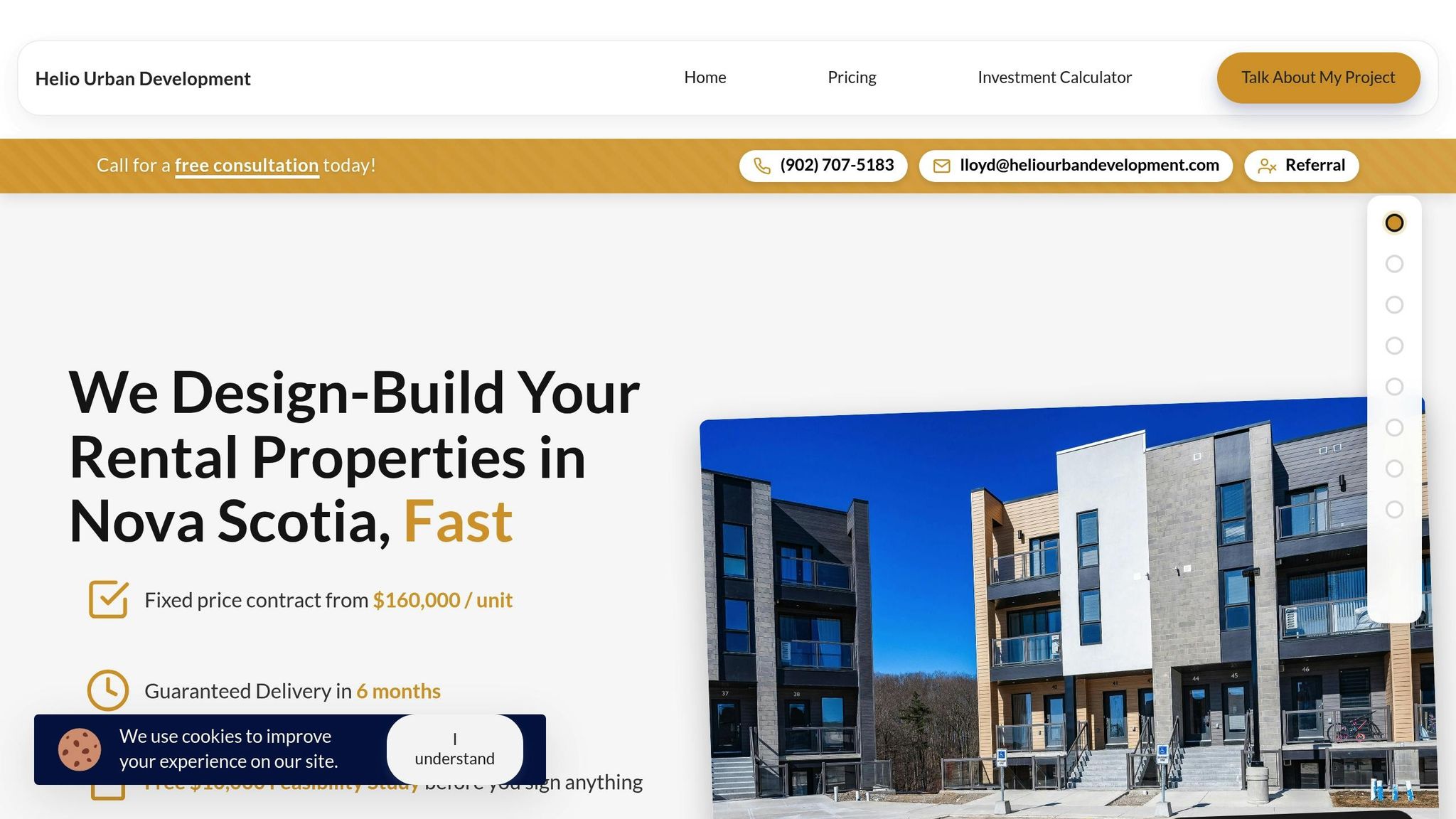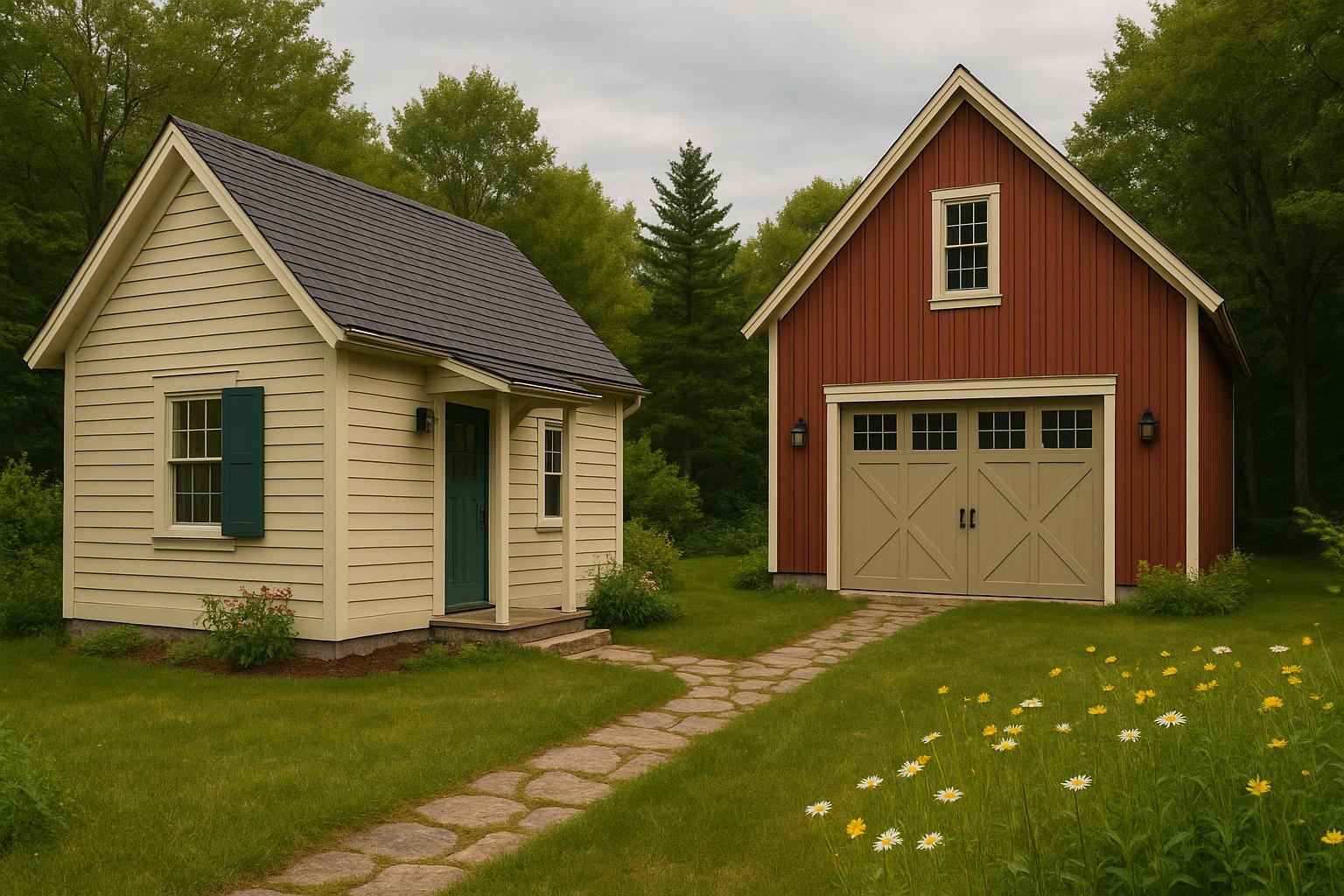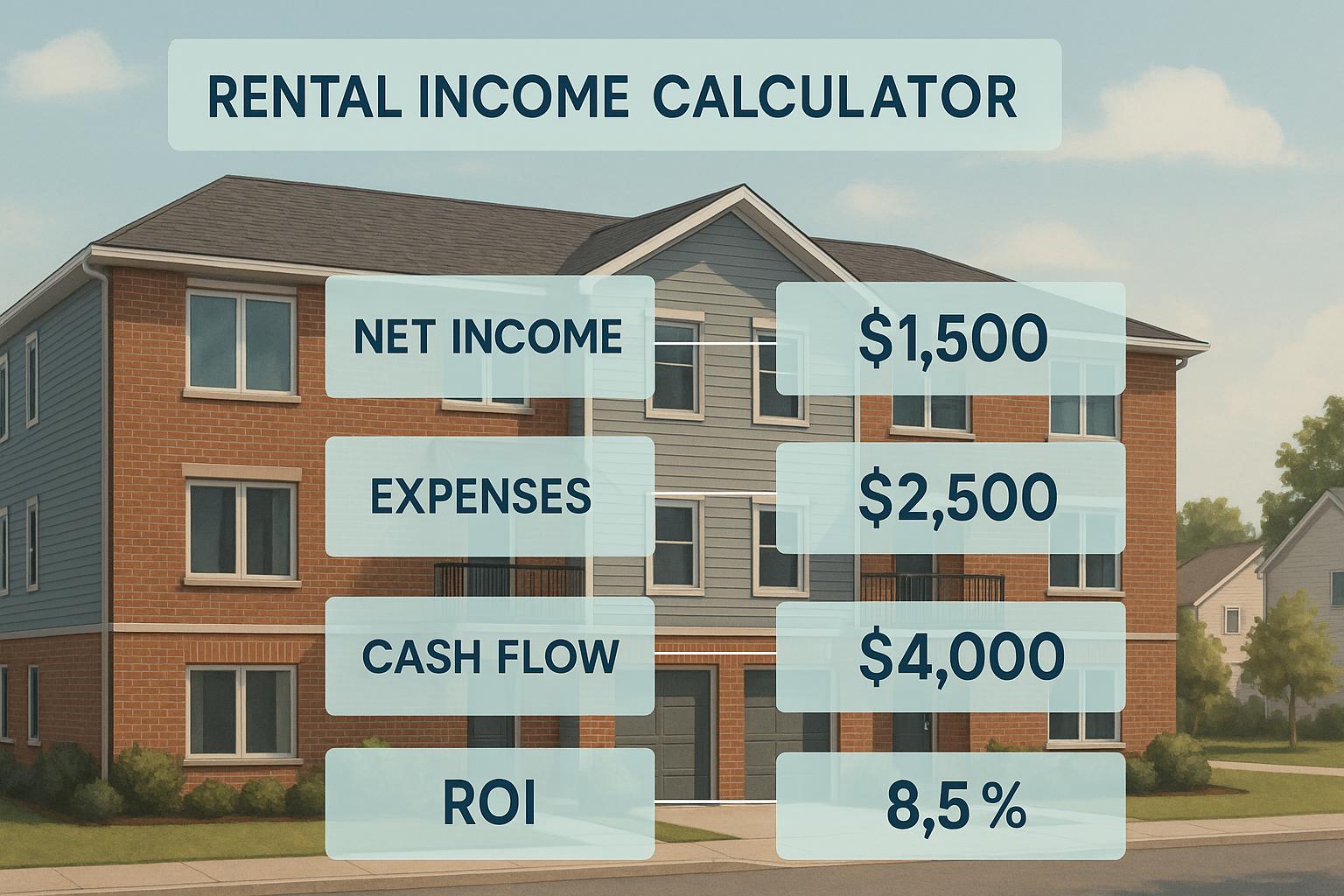How many storeys should you build for the best return on investment in Nova Scotia rental developments? This depends on balancing construction costs, rental income, and project efficiency. FAR-first massing, which maximizes zoning limits, is key. But traditional construction methods often lead to delays and cost overruns.
Key takeaway: Helio Urban Development offers a fixed-price, integrated design-build model ($160,000/unit, 6-month timelines) that simplifies the process, reduces risks, and ensures predictable ROI (12–20% annually). This approach eliminates common issues like miscommunication and unexpected expenses, making it easier to add extra storeys profitably.
Quick Overview:
- Traditional Approach: Flexible contractor selection but prone to delays, coordination issues, and cost overruns (30–60%).
- Helio’s Model: Fixed pricing, guaranteed timelines, and reduced coordination costs ($47,000 savings).
| Comparison Factor | Standard Approach | Helio’s Model |
|---|---|---|
| Cost | Variable, often overruns | Fixed at $160,000/unit |
| Timeline | 8–18+ months | 6 months guaranteed |
| Coordination | Fragmented | Single accountable team |
| Risk | High (owner bears risk) | Low (penalties for delays) |
| ROI Predictability | Uncertain | 12–20% annually |
Bottom line: If you want cost certainty, timely completion, and reliable ROI, Helio’s integrated model is a better option for projects with 4+ units.
Multifamily Development Model Walkthrough
1. Standard FAR-First Massing Method
The FAR-first massing method focuses on maximizing the zoned floor area, but adding extra storeys often comes with a steep increase in costs.
Construction Costs
Key building features - like height, shape, and footprint - play a major role in determining overall construction expenses [2]. For example, as a building's height increases, façade costs and other related expenses tend to rise disproportionately [2]. In Halifax, residential construction costs jumped by 8.4% in Q3 2023 [1], driven by labour shortages, supply-chain disruptions, and high interest rates. While costs have levelled off recently, the future remains uncertain due to both domestic and global economic changes [2]. This uncertainty highlights the advantages of using integrated design-build methods to better manage these challenges.
2. Helio Urban Development's Integrated Design-Build Method

Helio Urban Development has reimagined how FAR-first massing projects are handled by introducing a tech-driven, vertically integrated design-build approach. This method tackles the usual hurdles of adding extra storeys to rental properties, such as coordination headaches and unexpected costs, which are all too common in traditional construction.
Construction Costs
Helio's integrated model offers fixed-price construction at $160,000 per unit for standard multi-unit rental properties in Nova Scotia. This pricing structure removes the uncertainty often tied to cost-plus construction methods, where budgets can spiral out of control.
By uniting planners, architects, engineers, and construction teams under one roof, Helio helps property owners save up to $47,000 in coordination expenses. The vertical integration ensures there’s no blame game among contractors when challenges arise. Instead, every decision is made with the project's financial health in mind, creating a smoother process with fewer surprises. This cost certainty also leads to better scheduling and ensures deadlines are met.
Timeline Efficiency
Helio’s approach doesn’t just save money - it saves time. 93% of their projects are completed on schedule [3], a stark contrast to industry norms where 8-month timelines often stretch to over 18 months. Their tech-enabled tools, like a progress dashboard, give clients real-time updates, clear scheduling insights, and 24/7 access to site security cameras.
For fixed-price multi-unit builds such as duplexes, triplexes, and fourplexes in Nova Scotia, Helio provides an on-time delivery guarantee [4]. If a project is delayed, property owners are compensated with financial penalties of up to $1,000 per day. This commitment ensures rental income projections remain intact, protecting owners from losing out on the $8,800 per month they might otherwise miss due to delays.
By integrating schedules and streamlining contractor coordination, Helio eliminates the bottlenecks that often plague traditional builds. This means property owners can start collecting rent on time, keeping their income streams steady.
ROI Impact
Timely project completion and fixed pricing directly boost ROI for property owners. With rental rates ranging from $1,950 to $2,100 per month per unit, delays can quickly eat into expected returns. Helio’s fixed-price model ensures accurate financial planning, as construction costs are locked in, regardless of market changes.
Owners partnering with Helio can anticipate 12-20% annual ROI on their rental properties. By removing cost overruns from the equation, adding extra storeys becomes a more reliable and profitable investment.
Risk Mitigation
Traditional construction methods often carry risks like delays and budget overruns, but Helio’s integrated approach minimizes these uncertainties. Their tech tools and vertical integration provide property owners with full transparency, offering real-time updates on scheduling and progress through desktop and mobile platforms. This level of visibility eliminates the communication gaps that typically lead to project risks.
With a guarantee of on-time delivery for multi-unit properties, Helio effectively mitigates timeline risks that can derail rental income projections. Additionally, their two-year warranty on all construction work offers extra peace of mind, safeguarding owners’ investments.
This method replaces the traditional uncertainty of construction projects with a well-coordinated system. Every detail of adding extra storeys is carefully planned and executed by a single, accountable team, giving property owners confidence in both the process and the results.
sbb-itb-16b8a48
Pros and Cons
FAR-first massing for Nova Scotia rental properties highlights a clear contrast between traditional, fragmented construction methods and a more streamlined integrated design-build model. This section breaks down the main advantages and drawbacks of each approach.
Standard FAR-First Massing Method
The traditional method offers some initial benefits, such as lower upfront coordination costs and more flexibility in choosing contractors. Property owners can hire separate specialists, which may seem appealing for those wanting control over individual aspects of the project.
However, this approach often comes with serious challenges. Coordination among multiple professionals - often six or more - can become a logistical nightmare, leading to delays, cost overruns, and frequent disputes. Without a single point of accountability, resolving issues often turns into a blame game, which can derail timelines and inflate budgets.
Helio Urban Development's Integrated Method
The integrated design-build model takes a different approach, bundling design, engineering, and construction into one seamless process. This offers several key benefits for property owners focused on return on investment (ROI).
- Fixed Pricing: Construction costs are set at $160,000 per unit, eliminating budget uncertainty.
- Guaranteed Timelines: Projects are completed in six months, ensuring rental income streams - worth about $8,800 per month - are protected.
- Cost Savings: By avoiding coordination inefficiencies, property owners save around $47,000 in expenses.
- Transparency: Daily photo updates keep owners informed and involved.
That said, the integrated method does have some limitations. Owners lose flexibility in selecting individual contractors, and projects must meet a minimum size requirement of four units. While managing separate contracts may seem advantageous, it often results in delays and higher costs in the long run.
Key Comparison: Traditional vs. Integrated Methods
The table below highlights the major differences between the two approaches:
| Comparison Factor | Standard FAR-First Method | Integrated Design-Build |
|---|---|---|
| Construction Cost | Variable, with 30–60% overruns common | Fixed at $160,000 per unit |
| Timeline | Typically 8 to 18+ months | Guaranteed 6 months |
| Coordination & Accountability | Fragmented coordination | Single point of responsibility |
| Budget Certainty | Low, with cost-plus uncertainty | High, with locked-in pricing |
| Risk Mitigation | Owner bears most risk | Contractor penalties up to $1,000/day |
| Minimum Project Size | No minimum | 4+ units required |
| ROI Predictability | Difficult due to multiple variables | 12–20% annual ROI achievable |
The financial stakes become especially clear when factoring in rental income. Units renting for $1,950 to $2,100 per month mean that delays in construction can directly impact profitability. While traditional methods leave property owners vulnerable to unexpected costs and timeline extensions, the integrated model delivers predictable outcomes with measurable guarantees.
For property owners aiming to maximize returns on FAR-first massing projects, the integrated design-build approach offers a level of cost certainty and timeline reliability that often outweighs the perceived flexibility of traditional methods. What may seem like savings upfront with the traditional approach can quickly disappear due to inefficiencies and income losses caused by delays.
Conclusion
FAR-first massing forces a decision: do you prioritise flexibility or certainty?
Traditional construction methods might seem appealing due to their perceived flexibility. They allow you to pick contractors and avoid some upfront coordination costs. But this approach often comes with hidden risks - coordination issues and budget overruns that can climb as high as 30–60%. For property owners aiming to maximise vertical density, these inefficiencies can be costly, especially when rental income of $1,950 to $2,100 per unit is on the line.
On the other hand, the integrated approach trades some flexibility for predictable outcomes. Helio's model locks in fixed pricing, eliminates budget surprises, and ensures timelines are met, protecting rental income. With $47,000 saved in coordination inefficiencies alone, this approach often delivers more value than juggling multiple contracts.
The choice ultimately depends on your risk tolerance. If you're comfortable with fluctuating costs and longer timelines, traditional methods might work for smaller projects, especially those under four units. However, if your goal is to maximise ROI through FAR optimisation, the integrated model’s predictability can yield 12–20% annual returns by combining cost certainty with reliable timelines.
FAQs
How does Helio Urban Development’s design-build model provide a more reliable ROI for multi-unit rental projects?
Helio Urban Development uses an integrated design-build model that brings design and construction together into one seamless process. This method helps keep projects on track, reduces unexpected expenses, and ensures all teams work together from day one. By collaborating early, potential issues are addressed proactively, saving time and money.
With a single contract covering both design and construction, property owners enjoy clearer cost expectations, reduced risks, and a smoother project workflow. This approach makes it easier to manage budgets and stay focused on achieving your investment goals.
What are the risks of using a FAR-first approach for rental developments in Nova Scotia?
Using a FAR-first approach for rental developments in Nova Scotia has its challenges. Zoning regulations might turn out to be stricter than expected, which can lead to higher costs or limit the building’s allowable size. On top of that, if market trends shift, the design may no longer suit tenant preferences, potentially reducing rental income and overall returns.
This approach can also miss important opportunities, such as incorporating ground-floor retail spaces or meeting transparency requirements - both of which can be crucial for boosting long-term profitability. To navigate these risks, adopting a more adaptable and well-rounded planning strategy that considers local market demands and regulatory requirements is key.
How does the $160,000 fixed-price per unit model help property owners manage costs and minimise risks?
The $160,000 fixed-price per unit model gives property owners a straightforward and predictable way to manage their finances. With construction costs capped from the start, it removes the uncertainty of unexpected budget overruns and helps maintain steady cash flow throughout the project.
This pricing structure also minimizes financial risk by offering a single, transparent cost. Property owners can plan with certainty, knowing there won’t be surprise expenses or shifting charges during the build. It’s a practical, hassle-free way to keep your project on budget and running smoothly.



